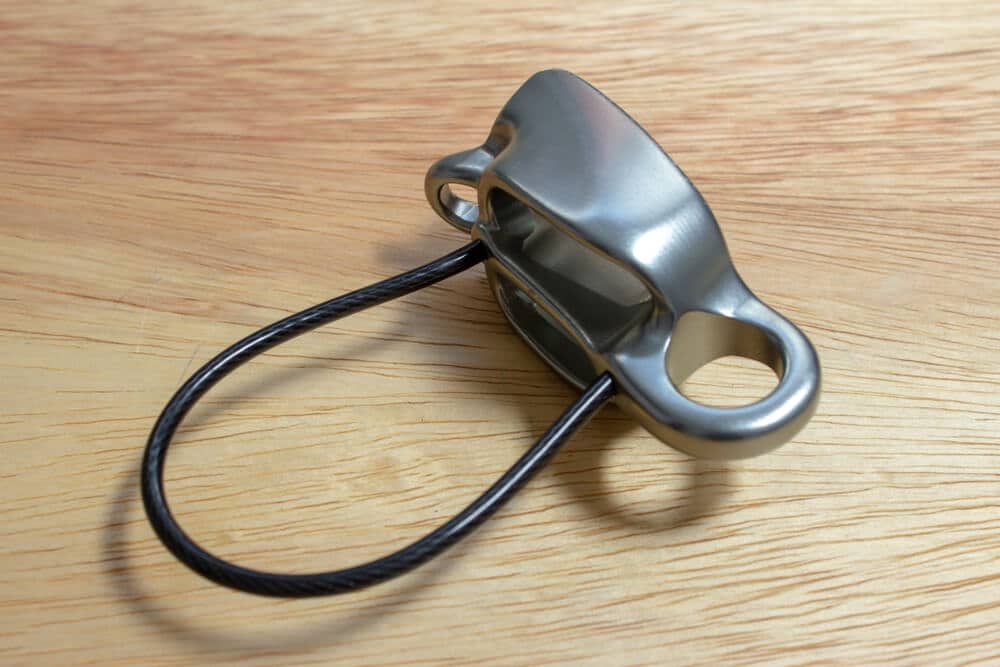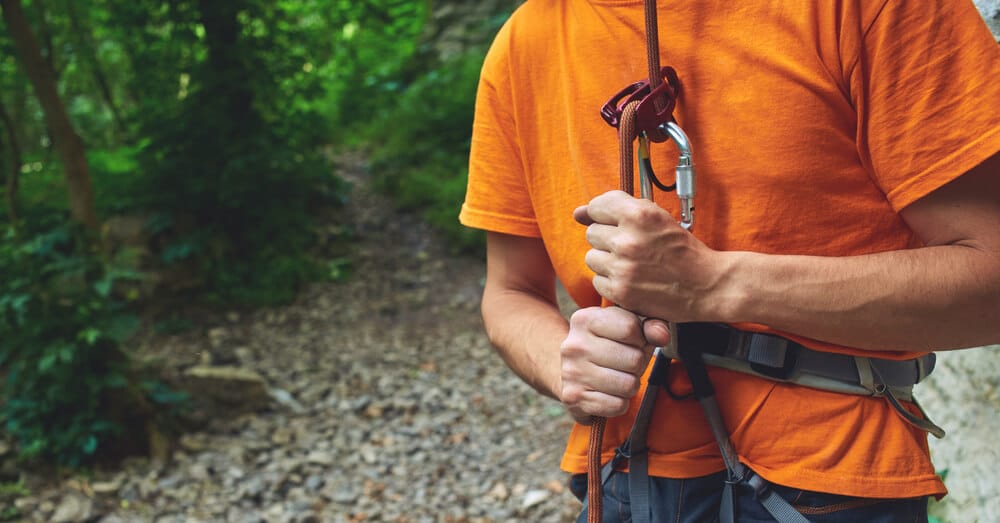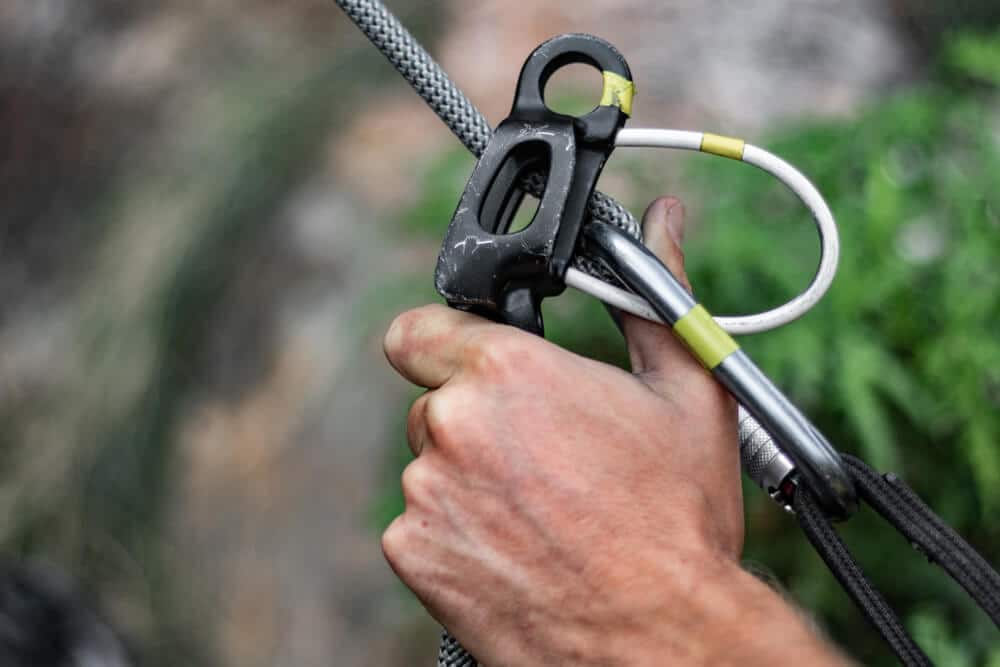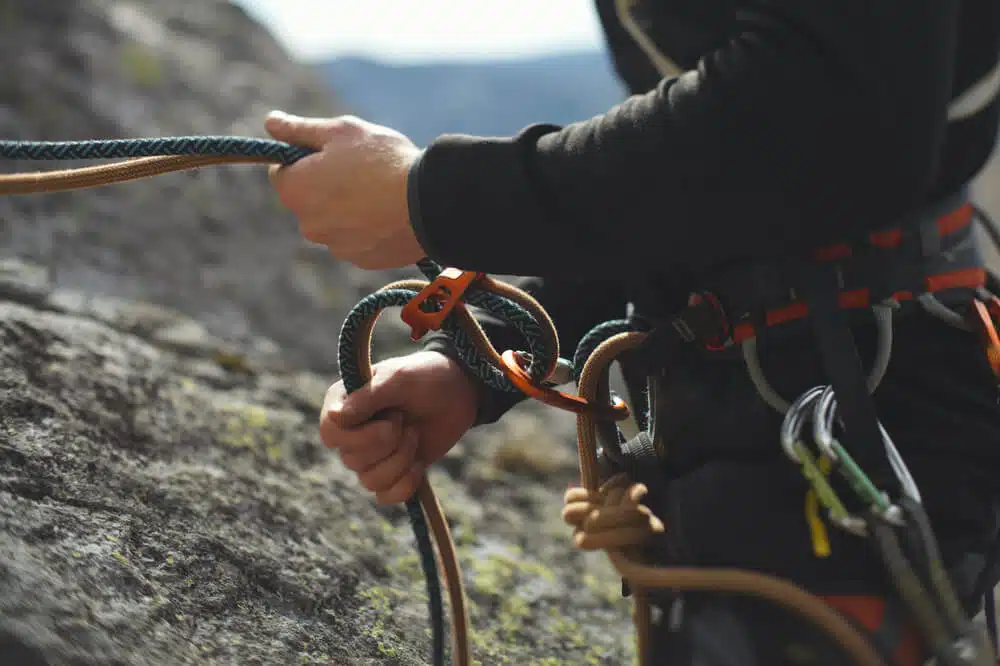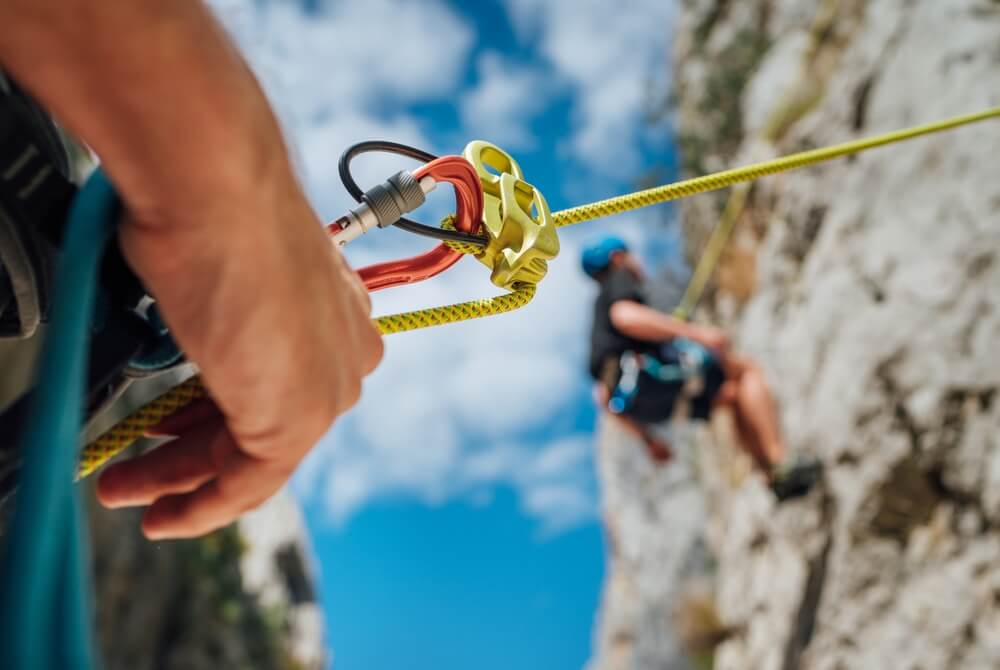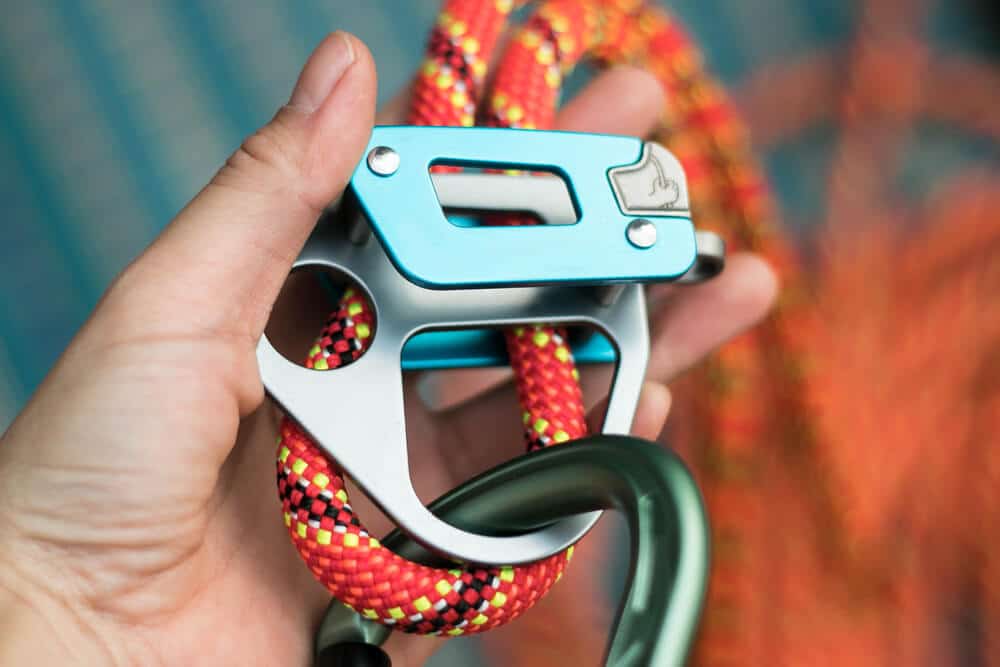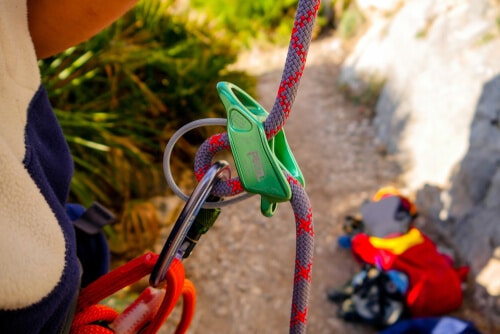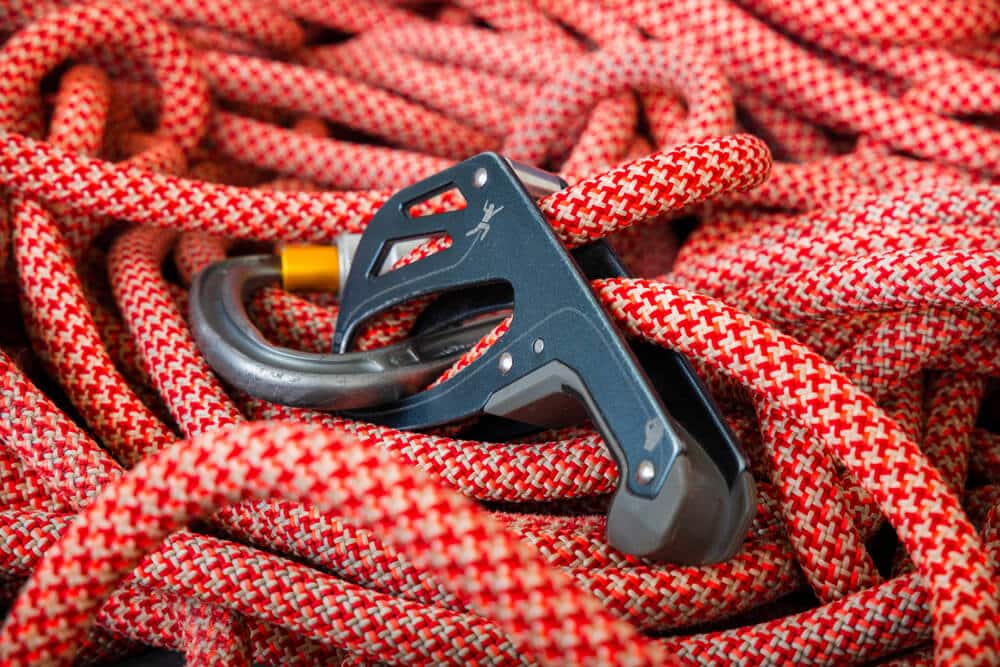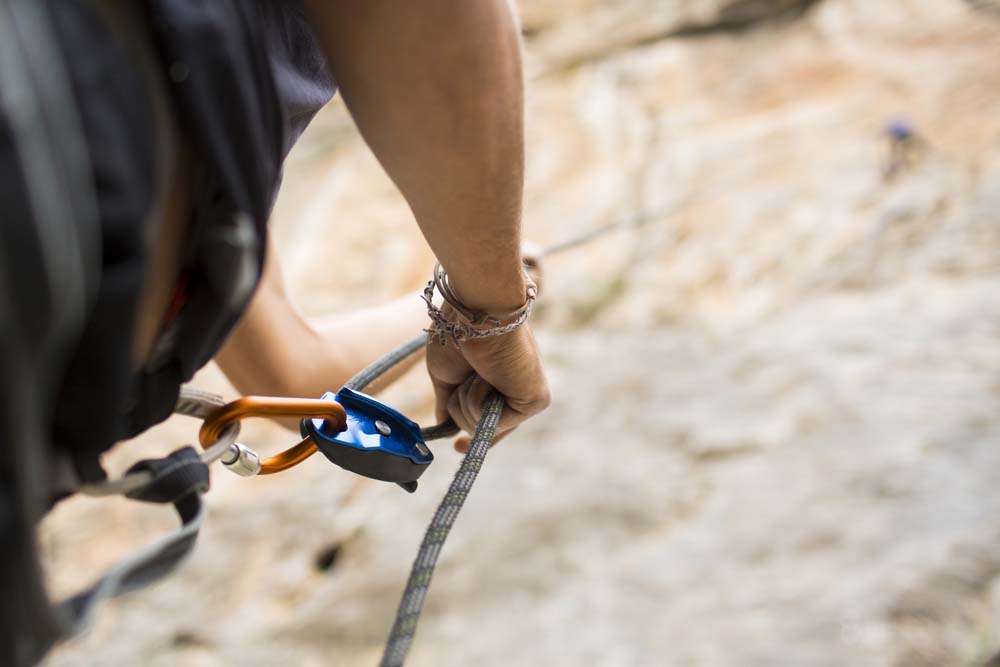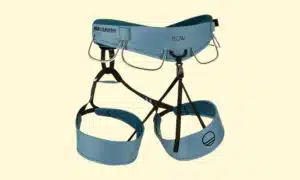If you’re asking that question, you’ve probably seen or heard of an ATC and know it’s used in rock climbing. But what exactly does an ATC do? What does the acronym ATC stand for? How useful is an ATC? What other devices can perform the same function?
Those are worthy questions for anyone interested in climbing. That’s because the trusty ATC is among the most popular and effective pieces of climbing gear. It’s nearly impossible to rope climb without an ATC or another belay device, so these devices and the principles behind them are something every climber should know and understand. Let’s learn everything we need to know about ATC climbing!
What is an ATC?
The ATC is a line of tubular belay devices produced by Black Diamond. The original Black Diamond “ATC” shares its name with an acronym that more commonly stands for “Air Traffic Controller.”
(This was a joke on the part of Black Diamond, given that the ATC’s primary use is to belay or “control” a climber high in the air on a rope, or allow a climber to control their descent.)
The Black Diamond ATC was so popular, affordable, and useful that it eventually went the way of the Band-Aid or Kleenex. Every tube-style belay device produced after the ATC, even by other brands, began to be referred to as an ATC, just like many people call all small adhesive bandages Band-Aids and tissue paper Kleenex.
Today, the Black Diamond ATC has expanded into an extensive line of belay rappel devices, including the ATC Guide, ATC Alpine Guide, ATC XP, and ATC Pilot, each offering slightly different advantages for specific use cases. There are also a number of other brands that produce similar devices.
What Does an ATC Do?
An ATC has two primary uses: belaying and rappelling. You can use an ATC-style device to belay a climber on top rope or lead, from above or below the climber, and you can also use it to belay two following climbers at once (or one climber using half and twin ropes).
You can also use an ATC to rappel or abseil, either on twin rope strands or a single fixed strand. The standard ATC, today, can accommodate a variety of ropes from 7.7 to 11 mm.
There are quite a few benefits to the ATC belay device and other tube-style belay devices, and for much of climbing history, these were the primary devices used for belaying, lowering, or rappelling.
In recent years, however, climbing brands have invented more advanced and specified belay rappel devices. Today, there are some situations where climbers prefer these devices over a traditional ATC. With that in mind, let’s go over the basics of ATC use, then talk pros and cons.
How to Use an ATC
An ATC works by generating friction via a tight bight (pinch) in the rope, allowing a climber to catch, hold and/or lower themselves, if rappelling, or their climber, if belaying. There is no substitute for proper climbing instruction, and this guide is not intended as such. What follows is a basic step-by-step of using an ATC.
-
Orientation: Hold the ATC so that the keeper wire is facing towards you, with the primary metal piece facing outward. Ensure that the climber side rope channel is facing upwards, and the “hand” strand is facing downward. This is typically indicated on the outside of the ATC via a small graphic. With a standard ATC this won’t matter. Both sides are the same. But with teethed devices or other modded tubers, it is important. Remember, the central cross bar dividing the two rope compartments should run vertically.
-
Load the Rope: Place a bite (pinch) of rope through the end of the ATC that’s facing away from you, on the same side as your dominant hand. Feeding the bite towards your harness, in line with the keeper.
-
Clip to Your Harness: Clip a locking carabiner through both the keeper wire and the bite of rope, securing (and locking) the other end of the carabiner through your harness belay loop.
-
Hand Position: Hold the brake strand with your dominant, or “brake” hand, keeping it at or behind the corresponding hip. Do not let go of the brake strand at any point. Use your non-dominant hand to manage the climber strand, feeding and taking rope as needed.
-
Belaying: How you belay will depend on whether your climber is leading or top roping/following. If the former, as they climb you’ll play out line with your non-dominant hand, keeping the brake strand controlled. If the latter, you’ll take slack as they climb. If the climber falls, your hand on the brake strand should grip the rope firmly, arresting the fall.
-
Lowering: To lower the climber, lift the brake end with your dominant hand away from your hip and release the rope gradually, while keeping control of the brake strand.
Benefits of Using an ATC
Versatility
An ATC belay device is perhaps the most versatile piece of climbing gear in existence. It can be used for belaying and rappelling, can incorporate one or two rope strands, and accommodates a variety of rope sizes.
It’s useful in top roping, sport climbing, trad climbing, multi-pitch and big wall, rope soloing, and alpine climbing. Basically, in any scenario where you climb with a rope, you can use an ATC.
Cost
ATCs and other tubular devices are usually the cheapest belay devices on the market. The standard Black Diamond ATC currently goes for around $20. The same goes for other ATC-style devices like the Petzl Verso ($25).
This is a far cry from popular mechanical devices (GriGri: $110) and is still more affordable than most passively assisted devices (Mammut Smart 2.0: $40). We’ll cover other devices more below.
Durability and Weight
The classic design of an ATC is incredibly simple, consisting of a single 60 g (2 oz) metal piece with a wire keeper stand. As such, they can take a hefty amount of abuse, and weigh next to nothing clipped onto a rack. I still have an ATC that I bought nearly 15 years ago, and though it doesn’t receive regular use anymore, it’s in good enough shape to offer belaying and rappelling performance anytime.
Education
An ATC is the simplest modern belay device, so it’s the best way to teach a new climber the basics of belaying and rappelling. A number of accidents have occurred in recent years due to climbers learning to belay with mechanically assisted devices like GriGris, and forgetting basic principles like always keeping a hand on the brake strand.
This means that an ATC is the best device for climbers to learn basic rope principles, before switching to more advanced devices for specific use cases.
Drawbacks of Using an ATC
Safety
ATCs are completely reliant on the belayer or rappeller’s proper use. If the user lets go of the rope, there is nothing to prevent a fall. Assisted devices, on the other hand, incorporate added backstops in the event of a user error. This can prevent accidents in many scenarios, such as if a belayer becomes incapacitated due to rockfall or a medical emergency.
Because of this, many climbing gyms require members to belay with an assisted device instead of an ATC. It’s important to note, however, that assisted braking devices like GriGris are not completely safe either. (Assisted does not mean “automatic.”)
Comfort
Some climbers find using mechanically assisted devices instead of tube-style ATC devices is more comfortable in certain scenarios, particularly sport climbing and top roping. This is because assisted devices often contain additional features, such as a cam lever, that make belaying and lowering easier.
Alternative Belay Rappel Device Options
As mentioned above, there are other belay rappel device options that some climbers use in lieu of an ATC. The three main categories of belay devices are tube-style (or tubular) devices like an ATC, passive assisted braking devices (PABDs), and active assisted devices (AABDs).
There are also older devices, like a horned figure-eight, although in modern climbing, these generally have very little upside save for those climbers who have grown up with them and prefer them for nostalgia sake.
Tube Style Braking Devices
Tube-style devices (or tubers) are the category that is often referred as ATCs, although there are other models in the space, such as the Petzl Verso. While most function quite similarly and feature the same classic design, some tubers offer additional features, like teeth to provide added rope grip or a “guide” (autoblock) loop used for belaying followers.
Passive Assisted Braking Devices
Also called “geometry assisted braking devices,” these devices are a cross between a fully user-operated device like an ATC and a mechanical device like a GriGri. A passive assisted device incorporates geometry and design to naturally promote safe braking.
There is no mechanical system in place to brake the rope, but the device itself is built in a way that it naturally pinches the rope between the device and a carabiner, depending on the position of the user’s brake hand.
The main benefits of passive assisted devices are cost, weight, and functionality. They’re quite cheap (though not as cheap as tubers), lightweight, and versatile, with some able to perform double-strand rappels and belays.
Popular examples of passive assisted devices include the Edelrid Giga Jul, Black Diamond ATC Pilot, Mammut Smart 2.0, Climbing Technology ClickUp+, Mammut Smart Alpine, and Edelrid Mega Jul.
Active Assisted Braking Devices
Also known as “mechanically assisted braking devices,” this family of devices is often trademarked by the wildly popular Petzl GriGri (although like with the former categories, there are plenty of similar models). Active brakers work via with a variety of mechanisms inside the device itself. They’re not dependent on the position of the brake hand, but they aren’t fully “failproof” either.
Some active assisted devices include Trango Vergo, Edelrid Eddy, Mad Rock Lifeguard, and Camp Matik. They are by far the most expensive model of belay device, and most don’t allow for two rope strands (or make sense for rappelling), but they also offer the greatest stopping power, safety, and comfort for most basic cragging scenarios.
Tip: You Can Belay with a Munter Hitch
If you’re stuck without a device, you can use a munter hitch to get off the wall or belay in a pinch. A munter can be used to belay either a leader or a follower, and rappel on single or double ropes. It’s not an ideal tool for regular belaying, because it will twist your rope up something fierce, but it’s useful if you’ve dropped your belay device.


